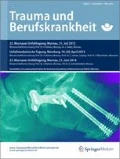Zusammenfassung
Kniegelenkluxationen sind seltene, aber schwer wiegende Verletzungen mit z. T. erheblichen Folgen. Begleitende Nerven- und Gefäßverletzungen sind nicht selten. Bei spontaner Reposition kann das Verletzungsausmaß initial unterschätzt werden. Die primäre Diagnostik muss die neurologische Untersuchung sowie die sichere Beurteilung des Gefäßstatus einschließen. Die Sicherung der Durchblutung des betroffenen Beins steht in der Akutphase im Vordergrund, Läsionen müssen notfallmäßig operativ versorgt werden. Bei drohendem Kompartment ist eine Faszienlogenspaltung erforderlich, die Instabilität wird temporär mittels Fixateur externe transfixiert. Bei Hochrasanztraumen sind Begleitverletzungen auszuschließen, bei sedierten und beatmeten Patienten z. B. mit Spiral-CT. Sind nur die Kreuzbänder betroffen, kann ein arthroskopisch gestützter Ersatz vorgenommen werden, Transplantate werden bevorzugt von der Gegenseite entnommen. Die im angloamerikanischen Sprachraum verwendeten Allografts haben sich in unserer Region noch nicht durchgesetzt. Bei ausgedehnten Kapselläsionen und Beteiligung der Kollateralbänder sind arthroskopische Techniken nicht indiziert, es sollte offen rekonstruiert und ggf. augmentiert werden; sekundär verbliebene Instabilitäten können gezielt dem Bandersatz zugeführt werden.
Abstract
Knee joint dislocations are serious injuries and may result in long term restrictions on recreational activity. Vascular disruption and nerve injury are not unusual. Spontaneous realignment is common and often leads to underestimation of the extent of the injury. The primary diagnostic assessment must include evaluation of the vascular and neurological status. In the acute phase the most important thing is to ensure the circulation in the affected leg: in the case of vascular damage urgent revascularisation must be performed; if the threat of a compartment syndrome is present fasciotomy is required.Instability is corrected temporarily using an external fixator. Following high-energy trauma associated injuries must be excluded, which can be done by means of a total-body spiral CT scan in sedated patients and those being mechanically ventilated, for example. Arthroscopically assisted ACL and PCL transplants can be performed in the case of isolated cruciate ligament injuries, allografts being preferred in the US and local tendons from the contralateral leg in Europe. In the presence of extensive capsular lesions and involvement of the collateral ligaments arthroscopy is not indicated; open reconstruction, and if necessary augmentation, are preferred in such cases. Ligament transplants can then be used if instability persists.



Literatur
Chhabra A, Cha PS, Rihn JA et al. (2005) Surgical management of knee dislocations. Surgical technique. J Bone Joint Surg Am [Suppl 1] 87: 1–21
Dubberley J, Burnell C, Longstaffe A et al. (2001) Irreducible knee dislocation treated by arthroscopic debridement. Arthroscopy 17: 316–319
Giannoulias CS, Freedman KB (2004) Knee dislocations: management of the multiligament-injured knee. Am J Orthop 33: 553–559
Gulotta LV, Gardner MJ, Rose HA et al. (2005) Periprosthetic patellar fracture after an open knee dislocation. Clin Orthop Relat Res 436: 265–269
Helgeson MD, Lehman RA Jr, Murphy KP (2005) Initial evaluation of the acute and chronic multiple ligament injured knee. J Knee Surg 18: 213–219
Hollis JD, Daley BJ (2005) 10-year review of knee dislocations: is arteriography always necessary? J Trauma 59: 672–675
Klineberg EO, Crites BM, Flinn WR et al. (2004) The role of arteriography in assessing popliteal artery injury in knee dislocations. J Trauma 56: 786–790
Kurtz CA, Sekiya JK (2005) Treatment of acute and chronic anterior cruciate ligament-posterior cruciate ligament-lateral side knee injuries. J Knee Surg 18: 228–239
Reckling FW, Peltier LF (2004) Acute knee dislocations and their complications. 1969. Clin Orthop Relat Res 422:135–141
Rihn JA, Groff YJ, Harner CD et al. (2004) The acutely dislocated knee: evaluation and management. J Am Acad Orthop Surg 12: 334–246
Robertson A, Nutton RW, Keating JF (2006) Dislocation of the knee. J Bone Joint Surg Br 88: 706–711
Shelbourne KD, Carr DR (2003) Combined anterior and posterior cruciate and medial collateral ligament injury: nonsurgical and delayed surgical treatment. Instr Course Lect 52: 413–418
Tzurbakis M, Diamantopoulos A, Xenakis T et al. (2006) Surgical treatment of multiple knee ligament injuries in 44 patients: 2–8 years follow-up results. Knee Surg Sports Traumatol Arthrosc 14: 739–749
Wilson TC, Talwalkar J, Johnson DL (2005) Lateral patella dislocation associated with an irreducible posterolateral knee dislocation: literature review. Orthopedics 28: 459–461
Wong CH, Tan JL, Chang HC et al. (2004) Knee dislocations – a retrospective study comparing operative versus closed immobilization treatment outcomes. Knee Surg Sports Traumatol Arthrosc 12: 540–544
Interessenkonflikt
Der korrespondierende Autor gibt an, dass kein Interessenkonflikt besteht.
Author information
Authors and Affiliations
Corresponding author
Rights and permissions
About this article
Cite this article
Gonschorek, O., Bühren, V. Kniegelenkluxationen. Trauma Berufskrankh 9, 128–132 (2007). https://doi.org/10.1007/s10039-007-1234-3
Issue Date:
DOI: https://doi.org/10.1007/s10039-007-1234-3

